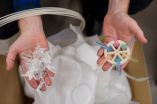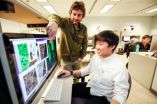(Press-News.org) Making your own stuff with a 3D printer is vastly cheaper than what you'd pay for manufactured goods, even factoring in the cost of buying the plastic filament.
Yet, you can drive the cost down even more by making your own filament from old milk jugs. And, while you are patting yourself on the back for saving 99 cents on the dollar, there's a bonus: you can feel warm and fuzzy about preserving the environment.
A study led by Joshua Pearce of Michigan Technological University has shown that making your own plastic 3D printer filament from milk jugs uses less energy—often a lot less—than recycling milk jugs conventionally.
Pearce's team did a life-cycle analysis on a run-of-the-mill milk jug made from HDPE plastic. After cleaning it and cutting it in pieces, they ran it through an office shredder and a RecycleBot, which turns waste plastic into 3D printer filament.
Compared to an ideal urban recycling program, which collects and processes plastic locally, turning milk jugs into filament at home uses about 3 percent less energy. "Where it really shows substantial savings is in smaller towns, where you have to transport the plastic to be collected, then again to be recycled, and a third time to be made into products," said Pearce, an associate professor of materials science and engineering/electrical and computer engineering. Then the energy savings skyrocket to 70-80 percent. And, recycling your own milk jugs uses 90 percent less energy than making virgin plastic from petroleum.
Pearce also compared the cost of making your own filament with buying it.
"Filament is retailing for between $36 and $50 a kilogram, and you can produce your own filament for 10 cents a kilogram if you use recycled plastic," he said. "There's a clear incentive, even if you factor in the cost of buying the RecycleBot."
Commercial variants like the Filastruder cost under $300.
HDPE plastic isn't ideal. "It shrinks slightly as it cools, so you have to take that into account," said Pearce. "But if you are making something like a statue or a pencil holder, it doesn't matter."
This new recycling technology has caught the eye of the Ethical Filament Foundation, which aims to improve the lives of waste pickers, who scour other people's trash for items to sell or recycle. "In the developing world, it's hard to get filament, and if these recyclers could make it and sell it for, say, $15 a kilogram, they'd make enough money to pull themselves out of poverty while doing the world a lot of good," he said.
INFORMATION:
The study, " Life-Cycle Analysis of Distributed Recycling of Post-consumer High Density Polyethylene for 3-D Printing Filament," by Megan Kreiger, Meredith Mulder, Alexandra Glover and Pearce, all of Michigan Tech, was published Feb. 12 in the Journal of Cleaner Production, http://dx.doi.org/10.1016/j.jclepro.2014.02.009 . An open access version is available from Academia.edu, https://www.academia.edu/6188555/Life_cycle_analysis_of_distributed_recycling_of_post-consumer_high_density_polyethylene_for_3-D_printing_filament
Save money and the planet: Turn your old milk jugs into 3-D printer filament
Study confirms energy and cost savings over standard recycling
2014-03-06
ELSE PRESS RELEASES FROM THIS DATE:
First-ever 3-D image created of the structure beneath Sierra Negra volcano
2014-03-06
The Galápagos Islands are home to some of the most active volcanoes in the world, with more than 50 eruptions in the last 200 years. Yet until recently, scientists knew far more about the history of finches, tortoises, and iguanas than of the volcanoes on which these unusual fauna had evolved.
Now research out of the University of Rochester is providing a better picture of the subterranean plumbing system that feeds the Galápagos volcanoes, as well as a major difference with another Pacific Island chain—the Hawaiian Islands. The findings have been published in the Journal ...
Sickle cell trait: Neglected opportunities in the era of genomic medicine
2014-03-06
(Boston)--While acknowledging the potential of genomics to prevent and treat disease, researchers from Boston Medical Center (BMC) and Boston University School of Medicine (BUSM) believe it is long past due to use current scientific data and technical advances to reduce the burden of sickle cell disease (SCD), one of the most common serious single gene disorders. The work, reported as a Viewpoint in this week's Journal of the American Medical Association (JAMA), highlights the gaps in knowledge and care in terms of SCD and the need to address this issue expeditiously. ...
Physician bias does not affect hypertension treatment for minority patients, says CU
2014-03-06
Doctors' unconscious biases favor whites but do not affect high blood pressure treatment for their minority patients, according to a University of Colorado Boulder study, even though a previous study by the same research group found that doctors' biases are reflected in lower ratings by African-American patients.
The new research, led by Irene Blair, an associate professor in CU-Boulder's Department of Psychology and Neuroscience, is published in the Journal of General Internal Medicine.
"We know that minorities have to face bias and discrimination in many different ...
Astronomers witness mysterious, never-before-seen disintegration of asteroid
2014-03-06
Astronomers have witnessed for the first time the breakup of an asteroid into as many as 10 smaller pieces. The discovery is published online March 6 in Astrophysical Journal Letters.
Though fragile comet nuclei have been seen falling apart as they near the sun, nothing resembling this type of breakup has been observed before in the asteroid belt. NASA's Hubble Space Telescope photographed the demolition.
"Seeing this rock fall apart before our eyes is pretty amazing," said David Jewitt, a professor in the UCLA Department of Earth, Planetary and Space Sciences ...
Hubble witnesses an asteroid mysteriously disintegrating
2014-03-06
The NASA/ESA Hubble Space Telescope has photographed the never-before-seen break-up of an asteroid, which has fragmented into as many as ten smaller pieces. Although fragile comet nuclei have been seen to fall apart as they approach the Sun, nothing like the breakup of this asteroid, P/2013 R3, has ever been observed before in the asteroid belt.
"This is a rock. Seeing it fall apart before our eyes is pretty amazing," said David Jewitt of UCLA, USA, who led the astronomical forensics investigation.
The crumbling asteroid, designated P/2013 R3, was first noticed as an ...
Transplanted human umbilical cord blood cells improved heart function in rat model of MI
2014-03-06
Putnam Valley, NY. (Mar. 6, 2014) – When human umbilical cord blood cells were transplanted into rats that had undergone a simulated myocardial infarction (MI), researchers investigating the long term effects of the transplantation found that left ventricular (LV) heart function in the treated rats was improved over those that did not get the stem cells. The animals were maintained without immunosuppressive therapy.
The study will be published in a future issue of Cell Transplantation but is currently freely available on-line as an unedited early e-pub at: http://www.ingentaconnect.com/content/cog/ct/pre-prints/content-ct0860Chen.
"Myocardial ...
Misplaced protein causes heart failure
2014-03-06
Colchicine, a drug that's used to treat gout, has the beneficial side effect of lowering the risk of heart attack in patients taking it. Conversely, taxol, a drug for treating cancer, has the opposite effect; raising the risk of heart failure.
What both these drugs have in common is that they act on microtubules – a network of fibers inside heart cells that provide internal structural support. Previous studies, including evidence from human patients and experimental models of heart failure, have suggested a link between heart failure and increased density of microtubules, ...
IUPUI researchers use computers to 'see' neurons to better understand brain function
2014-03-06
INDIANAPOLIS— A study conducted by local high school students and faculty from the Department of Computer and Information Science in the School of Science at Indiana University-Purdue University Indianapolis reveals new information about the motor circuits of the brain that may one day help those developing therapies to treat conditions such as stroke, schizophrenia, spinal cord injury or Alzheimer's disease.
"MRI and CAT scans of the human brain can tell us many things about the structure of this most complicated of organs, formed of trillions of neurons and the synapses ...
Complications following surgery predict costly readmissions
2014-03-06
The presence – or absence – of complications following surgery is a strong indicator of which patients are likely to be readmitted to the hospital in the 30 days following their procedure, according to a study published today in JAMA Surgery. Predicting which patients are most likely to experience complications using a simple online tool may allow healthcare professionals to flag patients at high risk of readmission in real time and alter care to reduce expensive trips back to the hospital.
The study examined more than 142,000 patients who had non-cardiac surgery using ...
Listening to whispers at the water cooler
2014-03-06
Just as she was about to retire, Lily Ledbetter, a production supervisor at an Alabama tire plant, learned that her employers had financially discriminated against her throughout her career. She filed suit for pay discrimination, losing due to a statute of limitations on equal-pay suits. As a result, President Barack Obama signed the Lily Ledbetter Fair Pay Act into law in 2009, drawing attention to the effects of pay secrecy on the workplace.
Now Prof. Peter Bamberger of Tel Aviv University's Recanati School of Business and Dr. Elena Belogolovsky of Cornell University's ...
LAST 30 PRESS RELEASES:
Scientists to ‘spy’ on cancer- immune cell interactions using quantum technology breakthrough
Tech savvy users have most digital concerns
Making lighter work of calculating fluid and heat flow
Normalizing blood sugar can halve heart attack risk
Lowering blood sugar cuts heart attack risk in people with prediabetes
Study links genetic variants to risk of blinding eye disease in premature infants
Non-opioid ‘pain sponge’ therapy halts cartilage degeneration and relieves chronic pain
AI can pick up cultural values by mimicking how kids learn
China’s ecological redlines offer fast track to 30 x 30 global conservation goal
Invisible indoor threats: emerging household contaminants and their growing risks to human health
Adding antibody treatment to chemo boosts outcomes for children with rare cancer
Germline pathogenic variants among women without a history of breast cancer
Tanning beds triple melanoma risk, potentially causing broad DNA damage
Unique bond identified as key to viral infection speed
Indoor tanning makes youthful skin much older on a genetic level
Mouse model sheds new light on the causes and potential solutions to human GI problems linked to muscular dystrophy
The Journal of Nuclear Medicine ahead-of-print tip sheet: December 12, 2025
Smarter tools for peering into the microscopic world
Applications open for funding to conduct research in the Kinsey Institute archives
Global measure underestimates the severity of food insecurity
Child survivors of critical illness are missing out on timely follow up care
Risk-based vs annual breast cancer screening / the WISDOM randomized clinical trial
University of Toronto launches Electric Vehicle Innovation Ontario to accelerate advanced EV technologies and build Canada’s innovation advantage
Early relapse predicts poor outcomes in aggressive blood cancer
American College of Lifestyle Medicine applauds two CMS models aligned with lifestyle medicine practice and reimbursement
Clinical trial finds cannabis use not a barrier to quitting nicotine vaping
Supplemental nutrition assistance program policies and food insecurity
Switching immune cells to “night mode” could limit damage after a heart attack, study suggests
URI-based Global RIghts Project report spotlights continued troubling trends in worldwide inhumane treatment
Neutrophils are less aggressive at night, explaining why nighttime heart attacks cause less damage than daytime events
[Press-News.org] Save money and the planet: Turn your old milk jugs into 3-D printer filamentStudy confirms energy and cost savings over standard recycling





